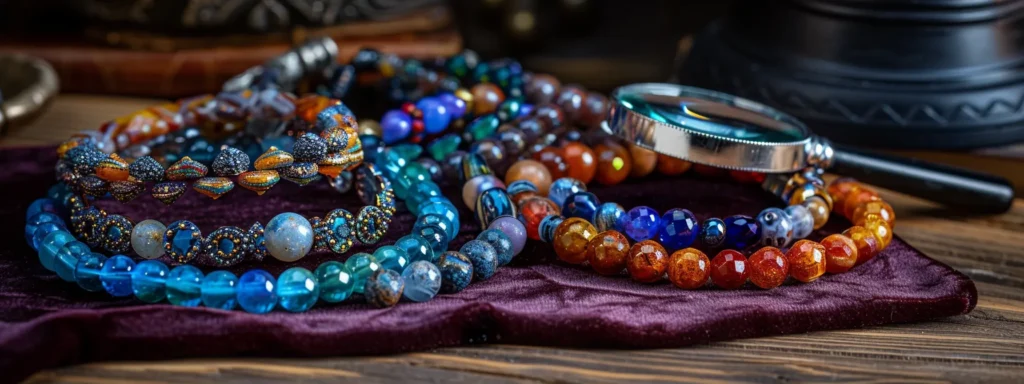Gemstones Therapy
Mastering Gemstone Identification for Your Bracelets
Mastering Gemstone Identification for Your Bracelets
Imagine your future adorned with exquisite real gemstone bracelets, each piece whispering a unique story of ancient mines and skilled artisans. A stunning ruby necklace or bracelet can be the statement piece you’ve always sought, reflecting both elegance and rarity. To truly appreciate these natural treasures, understanding how to identify genuine stones becomes essential. Embark on a journey into the world of gemstone identification, guided by techniques grounded in expertise from institutions like the Gemological Institute of America. By mastering this art, you not only elevate your collection but also empower yourself to make informed choices. Keep reading to unlock the secrets of recognizing authentic gemstones and enhance your jewelry experience!
Key Takeaways
- Assess gemstones under natural light to reveal true colors and variations
- Utilize tools like loupes and microscopes for detailed examination of clarity and inclusions
- Perform tests to measure specific gravity and refractive index for accurate identification
- Maintain organized records of observations to enhance future gemstone selections
- Consult professional gemologists for insights on rare gemstones and to confirm authenticity
Step 1 – Basic Observation: Color, Transparency, and Specific Gravity
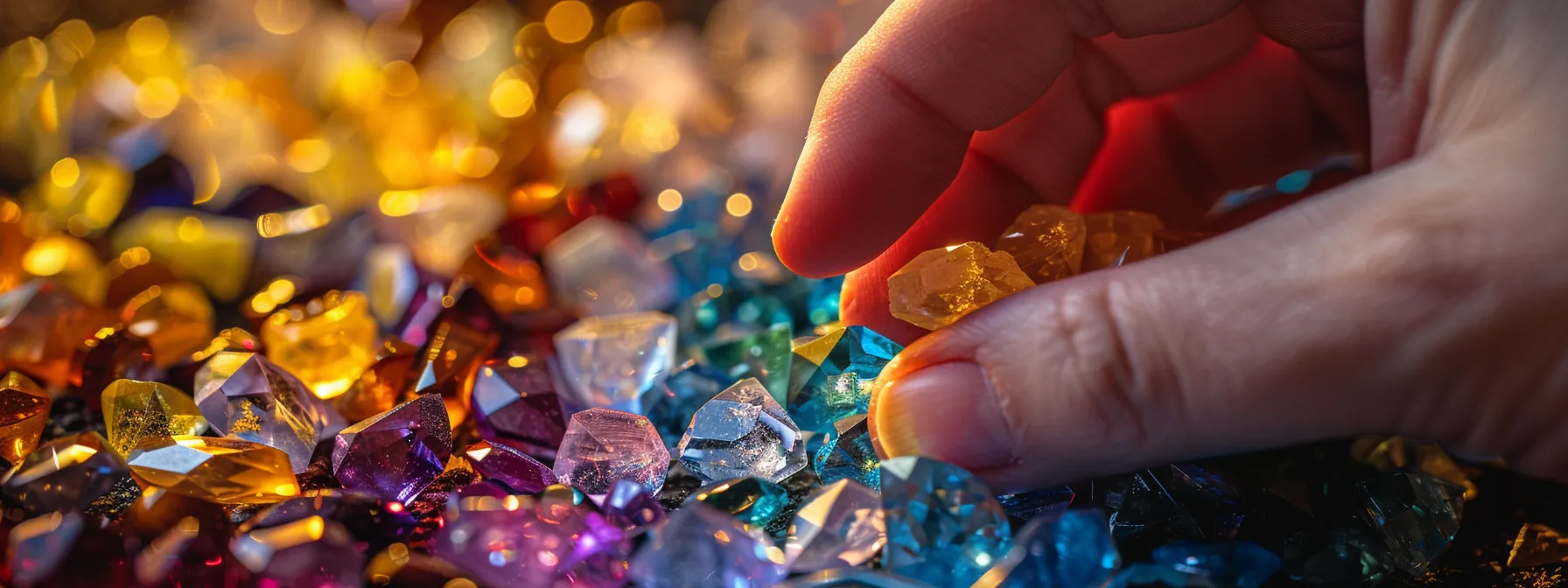
To effectively identify real gemstone bracelets for your Imagine your future, start by scrutinizing their color range under natural light, as this reveals the true hue of stones like quartz and spinel. Look for variations that indicate purity or the presence of trace elements such as iron, which may alter the appearance. Next, assess the transparency of each specimen using a simple light source; this will help you gauge the level of clarity, which is essential when considering refraction and the stone’s overall brilliance. Finally, determine the specific gravity with a straightforward water test, which not only gives insight into the gem’s density but also helps you calculate its carat weight accurately. This foundational observation step will set you up for a deeper understanding of how these factors contribute to the value and appeal of your selected gems.
Examine the Color Range Under Natural Light
When identifying gemstones, including the vibrant emerald, assessing color under natural light is paramount. The true hue of the stone becomes apparent in this setting, allowing you to spot any modifications caused by trace elements or imperfections that might affect its overall value, particularly in an auction context. Tools such as a microscope can enhance your examination, helping you observe details like birefringence, which indicates how light interacts with the stone, and can affect its perceived density.
Assess Transparency Using a Simple Light Source
To accurately assess a gemstone‘s transparency, utilize a simple light source, such as a LED flashlight or even natural sunlight. This method allows you to see how light passes through the gem, revealing its clarity and brilliance, which are significant in gemology. This knowledge is vital for lapidaries, as it can also guide you in determining how well the stone will pair with yellow gold in your bracelets.
Determine the Specific Gravity With a Water Test
To measure the specific gravity of a gemstone accurately, fill a container with water and allow the gem, such as a topaz or diamond cut stone, to rest within it under gentle pressure. As the stone displaces the water, you can calculate its weight relative to the amount of water displaced, giving you insight into its density and helping you make informed decisions for your bracelet design. Keep an eye out for fluorescence during this process, as it can indicate additional characteristics of the stone, enhancing your understanding of its unique qualities.
Now that you’ve grasped the fundamentals of your sample’s characteristics, it’s time to elevate your exploration. Get ready to shine a light on your findings and examine the stunning optical phenomena and luster that reveal even more about your treasure.
Step 2 – Light It and Loupe It: Optical Phenomena and Luster
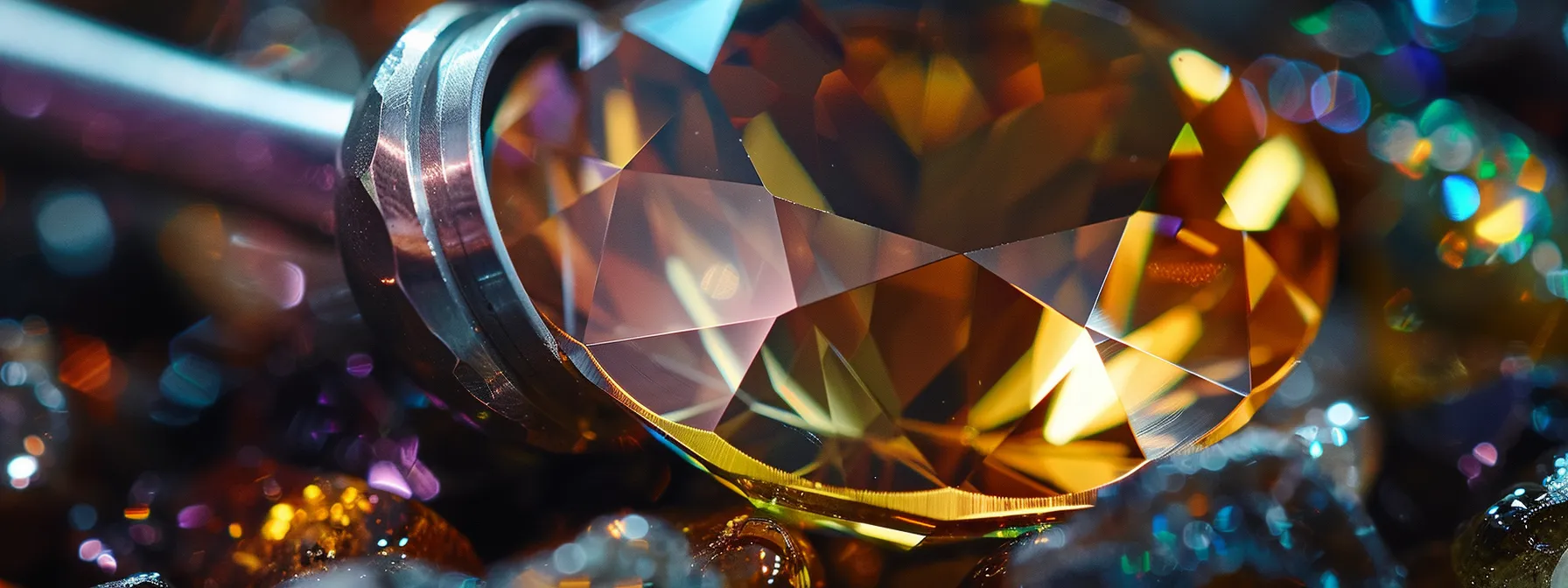
Now that you’ve laid the groundwork with basic observations, it’s time to elevate your gemstone identification skills further. Use a loupe to examine surface patterns and inclusions, which can reveal a gemstone’s mineral composition and authenticity. Pay close attention to how your stones react to light, as this interaction directly impacts their luster, an essential factor in determining their allure, especially when paired with sterling silver in a necklace. Additionally, look for unique optical phenomena like the play of color, which can transform the appearance of gemstones and provide insights into their value and character. By honing these observational techniques, you will deepen your understanding of each gemstone‘s individuality and refine your selection process for your bracelet designs.
Use a Loupe to Identify Surface Patterns and Inclusions
As you take the loupe in hand, focus your attention on the surface of your garnet or any lab-created gem. This close examination will help you uncover unique surface patterns and inclusions, which are key indicators of authenticity and fineness. Not only will you gain insights into the gem’s quality, but you will also develop a deeper appreciation for its individuality, making your bracelet designs even more meaningful.
Observe the Gemstone‘s Reaction to Light for Luster
As you inspect your crystal with a loupe, pay attention to how it interacts with light. Observing the luster can reveal not only the quality of the stone but also its refractive index, which is crucial in distinguishing gems like pyrite from others. Utilizing a refractometer can enhance your analysis, allowing you to accurately gauge the gemstone‘s unique properties and reflect on its value in your bracelet design.
Note Any Unique Optical Phenomena Like Play of Color
As you explore unique optical phenomena, keep an eye out for the captivating play of color found in gemstones such as opal. This mesmerizing effect can turn an ordinary stone into a vibrant birthstone, adding an element of wonder to your bracelet. The way light interacts with the opal’s internal structure can produce a spectrum of colors, making it ideal for setting alongside silver or other metal accents to enhance its visual appeal.
Armed with a clear understanding of optical phenomena and the captivating luster of your material, you’re ready to uncover its hidden properties. Get ready to dive into the world of refractive index and birefringence, where the true nature of your gem begins to reveal itself!
Step 3 – Determining Refractive Index and Birefringence

To refine your gemstone identification skills even further, it’s time to delve into determining the refractive index and birefringence of your stones. Begin with a refractometer test for accurate measurements, which is crucial for recognizing the distinct characteristics of gems like tourmaline. Next, employ polarized light to check for signs of birefringence, helping you assess the internal structure and optical behavior of the stone. Remember to meticulously record your findings for later comparison, as these insights will significantly enhance your understanding of each gemstone‘s unique traits, paving the way for more informed decisions in your bracelet designs.
Conduct a Refractometer Test for Refractive Index
To conduct a refractometer test, you should place your gemstone on the prism of the refractometer, ensuring proper alignment for an accurate reading. By shining a light through the stone, the instrument calculates how much the light bends as it passes through, providing you with the refractive index. Understanding this value is essential because it allows you to distinguish between various gemstones and further confirm their authenticity, enhancing your confidence in selecting the right stones for your bracelet designs.
Use Polarized Light to Check for Birefringence Signs
To check for birefringence in your gemstones, position your stone between the polarized light source and the observation lens. This technique allows you to observe any variations in the stone’s appearance, indicating how light behaves as it passes through different orientations. By carefully analyzing these changes, you can gain insight into the characteristics and quality of the gem, which is critical in your selection process.
- Prepare your polarized light setup.
- Place the gemstone between the light source and observation lens.
- Observe variations in appearance for signs of birefringence.
- Assess the gem’s characteristics for informed selection.
Record Your Findings for Later Comparison
Maintaining a detailed log of your gemstone analysis is critical for future reference. By systematically recording your findings, including refractive indices and birefringence results, you create a valuable resource for refining your bracelet selection process. This documentation not only aids in comparison but also fosters confidence in your selections moving forward:
- Document the refractive index for each gemstone tested.
- Note the birefringence observations during your polarized light examinations.
- Keep records organized for easy access and review as you progress.
With the refractive index and birefringence established, you’re on the brink of an important discovery. Let’s dive into the next phase and uncover the distinctions between single and double refraction!
Step 4 – Determining Single vs. Double Refraction
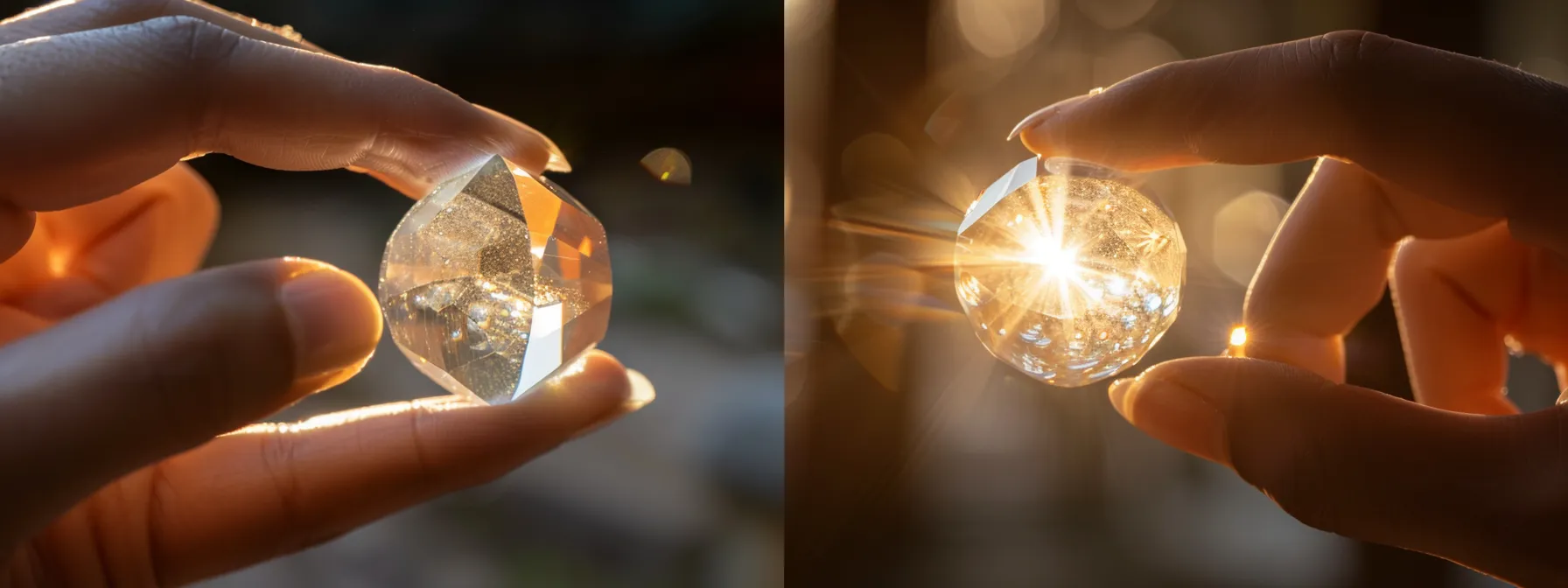
As you progress in your gemstone identification journey, understanding the distinction between single and double refraction becomes vital. Employ the dot test to clearly assess how light behaves as it interacts with your gems; this technique allows you to identify whether a stone exhibits single or double refraction characteristics effectively. After performing this test, compare your observations with standard gemological charts to verify your findings and ensure accuracy. Finally, meticulously record your results, as these notes will provide invaluable support in confirming the identity of each gemstone, further refining your selection process for exquisite bracelets.
Apply the Dot Test to Identify Double Refraction
To effectively apply the dot test, place your gemstone on a flat surface and draw a dot on a piece of paper beneath it. As you look through the gem, pay attention to how many dots you see; if there are two, this indicates that the stone exhibits double refraction, while a single dot signifies single refraction. This simple yet effective technique not only sharpens your identification skills but also enhances your understanding of the gem’s optical properties, crucial for creating stunning bracelet designs.
Compare Observations With Standard Gemological Charts
After completing the dot test, it’s crucial to compare your findings with standard gemological charts. This step allows you to verify whether your observations align with the established characteristics of various gemstones. By checking against these reference materials, you enhance your accuracy in identifying stones and gain confidence in your selections.
Utilizing these resources enhances your understanding of gemstone properties and informs your design decisions for bracelets.
Record Results to Aid in Final Identification
To aid in the final identification of your gemstones, create a systematic record of your findings during testing. This log should include details of the optical characteristics observed, such as whether the gem shows single or double refraction, along with any notable observations. Consistently updating this documentation helps solidify your understanding and provides a reliable reference in your ongoing gemstone journey.
- Conduct the dot test to determine the type of refraction.
- Record the number of dots observed for each gemstone.
- Compare your notes with standard gemological charts.
- Maintain organized records for easy access and review.
You’ve unraveled the mysteries of single and double refraction, laying the groundwork for your next move. It’s time to put your knowledge to the test and make your identification!
Make Your Identification!
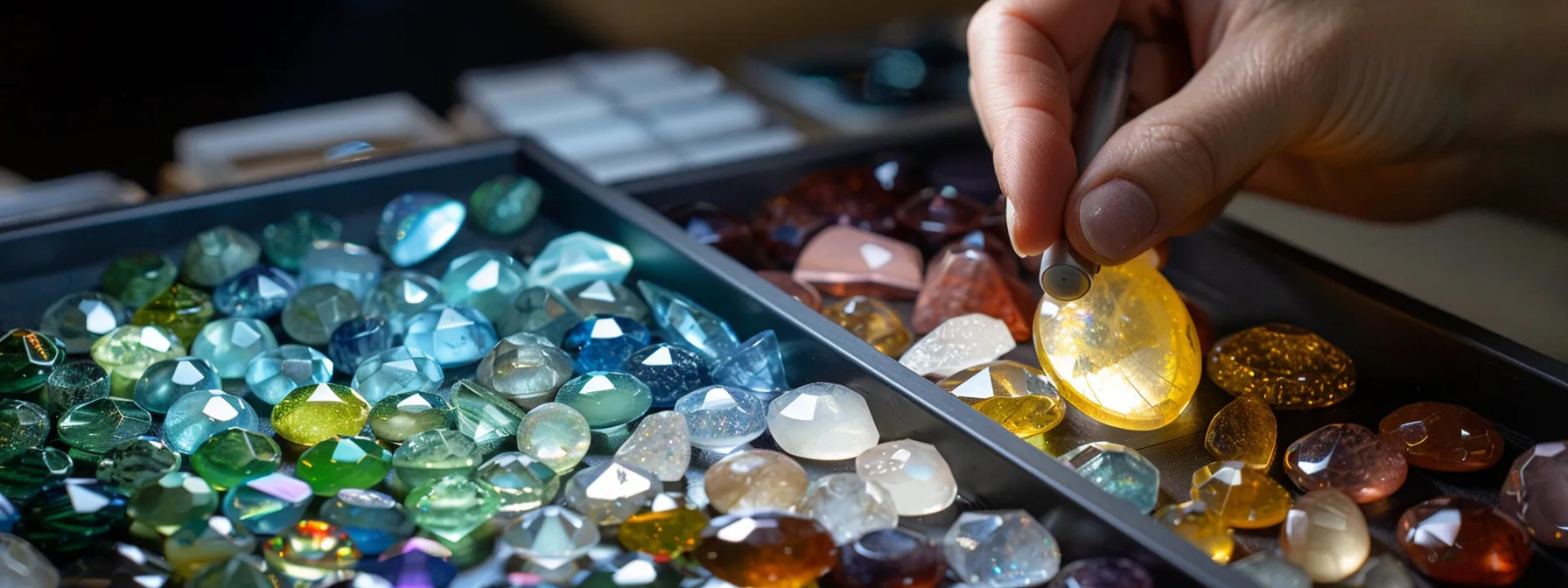
To complete your gemstone identification process effectively, cross-reference the properties you have observed with a reliable gemstone database. This step will help you confirm your findings and deepen your understanding of the stones in your collection. For rare or particularly valuable gemstones, consider reaching out to a professional gemologist who can provide insights that may not be easily accessible through standard resources. Once you’ve gathered all your information, ensure you label and document each gemstone meticulously. Not only does this create a clear record for your collection, but it also enhances your ability to share knowledge and inspire others interested in the art of gemstone jewelry design.
Cross-Reference Observed Properties With a Gemstone Database
To ensure accurate identification of your gemstones, always cross-reference the properties you’ve recorded with a reputable gemstone database. This step enhances your confidence in recognizing different stones and their unique traits, allowing you to refine your selections for your bracelet designs. Comprehensive databases are invaluable as they provide detailed information on color, refractive index, and other distinguishing features that will aid in confirming your observations.
- Review the properties for each gemstone.
- Utilize a reliable gemstone database for verification.
- Enhance your understanding of distinct characteristics.
- Refine your gemstone selections for your bracelets.
Consider Consulting With a Professional for Rare Finds
When you encounter rare or unique gemstones, consider reaching out to a professional gemologist. These experts possess the skills and tools necessary to evaluate stones accurately, revealing aspects that might not be apparent during your initial assessment. Their insights can greatly enhance your understanding and appreciation of the gemstones you wish to incorporate into your bracelets:
Engaging a professional helps ensure that your investment in jewelry reflects its true worth, allowing you to design bracelets that captivate and impress.
Label and Document Your Gemstone for Your Collection
Take the time to label each gemstone in your collection with detailed information, including its type, characteristics, and any notable features you’ve observed. Accurate documentation enriches your understanding of each piece, allowing you not only to track your collection but also to share its story with others. This meticulous approach not only enhances your confidence in your selections but also fosters an appreciation for the beauty and uniqueness of your gemstones.



